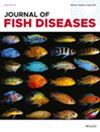Enterolith with a bonefish spine nidus in a Brazilian cownose ray Rhinoptera brasiliensis (Müller & Henle) (Myliobatiformes: Rhinopteridae)
IF 2.2
3区 农林科学
Q2 FISHERIES
引用次数: 0
Abstract
An adult female Brazilian cownose ray (Rhinoptera brasiliensis), housed in Ubatuba Aquarium died after loss of appetite period. During necropsy, an enterolith was discovered partially obstructing the intestinal lumen. Examination of the enterolith revealed a bonefish spine nidus. Enterolithiasis has been linked to multiple factors including diet, genetics, alkaline intestinal environments and, as in this particular case, the ingestion and retention of foreign bodies. The composition of this enterolith from a cownose ray was primarily monohydrocalcite. This short communication, apparently the first to report enterolithiasis in stingrays, emphasizes the need for post-mortem examinations of carcasses on macroscopic and microscopic levels.
巴西牛鼻魟(Rhinoptera brasiliensis (Müller & Henle))体内带有骨刺巢的肠石(Myliobatiformes: Rhinopteridae)。
乌巴图巴水族馆饲养的一条成年雌性巴西牛鼻魟(Rhinoptera brasiliensis)在食欲不振期后死亡。在解剖过程中,发现一块肠石部分阻塞了肠腔。对肠石的检查发现了骨鱼脊骨巢。肠石症与多种因素有关,包括饮食、遗传、碱性肠道环境,以及本病例中异物的摄入和滞留。这块来自牛鼻魟的肠结石的成分主要是单氢方解石。这篇简短的通讯显然是首次报道黄貂鱼肠结石,它强调了对尸体进行宏观和微观检查的必要性。
本文章由计算机程序翻译,如有差异,请以英文原文为准。
求助全文
约1分钟内获得全文
求助全文
来源期刊

Journal of fish diseases
农林科学-海洋与淡水生物学
CiteScore
4.60
自引率
12.00%
发文量
170
审稿时长
6 months
期刊介绍:
Journal of Fish Diseases enjoys an international reputation as the medium for the exchange of information on original research into all aspects of disease in both wild and cultured fish and shellfish. Areas of interest regularly covered by the journal include:
-host-pathogen relationships-
studies of fish pathogens-
pathophysiology-
diagnostic methods-
therapy-
epidemiology-
descriptions of new diseases
 求助内容:
求助内容: 应助结果提醒方式:
应助结果提醒方式:


